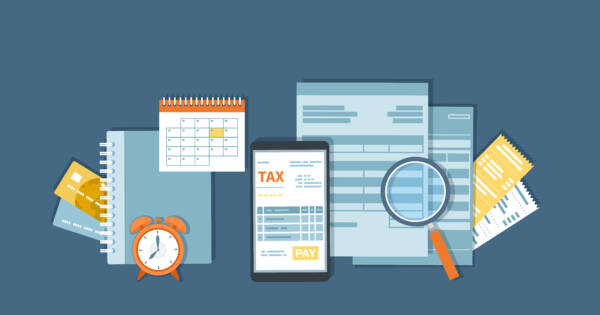Most of us set out to do our taxes with two specific goals in mind: try to pay as little we can to the IRS and maybe — if we’re super lucky — get a decent refund. Those are perfectly reasonable goals to aim for, but it’s not necessarily easy to recall (or even know in the first place) how we should go about lowering that tax bill. It’s worth pointing out, we suppose, that a refund if actually just getting your own money back. You merely lent it (interest free) to the government. While a decent refund can be a nice boost to your budget, there’s an argument that it’s actually better to to try and be as close to even with the IRS as possible. That is, not owing or being owed a substantial amount. It’s your money, after all.
We’re here to remind you. From deductions to retirement plans, tips to tuition — there are strategies for nearly every taxpayer to take advantage of some tax relief. Sometimes we just need a little help deciding what strategy to take — which is where we’ll start. Should you go ahead and spend the time itemizing your deductions, or should you just go for the standard deduction and hope it was worth the time it took?
10. Itemize …
There’s no more important tax decision than deciding whether to itemize. (Well, deciding to file at all is pretty important. But don’t get in the habit of thinking you have much choice in that.) Here’s the deal: The government gives you two options. One is the standard deduction, which changes depending on your filing status. (In 2020, it’s $12,400 if you’re filing as a single person and $24,800 for those married filing jointly.)
Seems appealing, right? It can be. But don’t discount how important it is to make sure that you’re not lowering your tax bill by itemizing all your deductions. You can write off all sorts of things — from (some) medical expenses to charitable donations. Most worthwhile is your mortgage interest. As a result of tax reform, you may write off interest associated with the first $750k of mortgage principal for mortgages originated after December 15, 2017. For mortgages originated prior, you may write off interest associated with the first $1m of mortgage principal and $100k of principal from a home equity loan.
9. … Or Don’t
Okay, remember what we just said about how you should totally itemize? Forget it. Don’t.
Or more specifically, don’t assume that all your little deductions are going to be worthwhile to take. As we alluded earlier, not every itemized deduction is worth your while. Consider the medical expenses deduction: If you’re thinking you can just write off the cost of all the medical bills you paid this year, think again.
The actual rule? You can deduct medical expenses that exceed a certain pecentage of your adjusted gross income. So, let’s say that you have $10,000 in medical expenses, and your adjusted gross income is $50,000. You can only write off $6,500 of those expenses, because the other $5,000 is under that 10 percent limit. This deduction is super confusing because it keeps changing annually after tax reform. As of tax year 2020, the amount is 7.5% of your AGI.
So, do be sure you’re being smart about taking or not taking that deduction, because you might find yourself making your taxes higher than they ought to be.
8. Check Your Withholding
Some solutions to lowering your taxes are amazing tricks. Some are options that work well for some, but don’t have nearly the same effect for others. But some solutions for making those taxes go south are as straightforward as they come. Case in point: lower your taxes at filing time by paying enough taxes throughout the year.
Here’s why it makes sense: If you’re getting walloped with a giant tax bill every April, chances are that you or your employer are not withholding enough from your account. Luckily, there are a few different ways to address that problem.
One of them is to simply request more withholding from your paycheck. That’s easy enough: Just fill out an amended W-4 with your employer. If you’re earning money from freelance work or have some other income that’s affecting your taxes, you really should consider making estimated payments for your taxes. In fact, you might even be obligated to. While it won’t lower your tax bill, it will help you avoid paying a huge bill at the end of the year.
7. Feed Your Retirement Plan
A lot of people consider using a retirement plan to help lower their taxes. And it might sound totally nuts. After all, why would putting money in some retirement account save you money? It’s still sitting in a fund, after all, waiting for the government to grab a piece.
Not quite. Some retirement plans really do provide some big tax breaks. One option is a 401(k). You can put in a whopping $19,500 into your 401(k) each year ($26,000 if you are 50 or older). And here’s the kicker: That income doesn’t count as taxable income. In other words, you can pretty much delete up to $19,500 from your income [source: Block].
But beware: Nothing is free. Because you’re not getting taxed when you contribute to your 401(k), you are going to get taxed when you distribute the funds. When your 401(k) starts paying out, you’re going to have to treat any income you receive from it as taxable. Just remember not all retirement plans are made alike: IRAs and Roth IRAs work a little differently, and some contributions are taxable.
6. Check Out Section 179
There’s nothing like buying something really, really expensive to lower that tax bill! While it might technically save you some taxes, it’s pretty much a horrible financial plan to buy a $25,000 car just because you can write it off.
But here’s the thing: If you have to buy a car — say, for your business — it can come in really handy to write the whole thing off the year you buy it. Usually you’d have to depreciate it, meaning that you can write a portion of it off for every year you own or use it. That’s cool too, since you get a small deduction for many years. But Section 179 works a little differently.
Not just anybody can use it. You need to be either self-employed or own a business to take it. But it basically says that any equipment you buy (up to $1,000,000 in 2020) can be entirely written off the year you bought it [source: Ebeling]. Just check out the specific rules to make sure you qualify.
5. Take Advantage of a Flex Plan
We’ve talked about some ways that itemized deductions can only lower taxes in specific ways. For instance, itemizing medical expenses doesn’t always pay when you can only write off the excess of 7.5 percent of your adjusted gross income. But what if we told you there was a handy dandy way to pay off those medical expenses tax-free, regardless of whether you itemize?
It sounds like a too-good-to-be-true infomercial (“How can that towel absorb so much liquid?!”), but it’s written right into the tax code. If your employer offers a flexible spending plan as part of your medical package, put the maximum $2,750 into it [source: IRS 969]. The money is taken directly from your paycheck, and you don’t have to count it as income, thus lowering your taxes — and possibly your tax bracket.
A health savings account can also lower your taxes. While it technically won’t decrease your income, you can deduct the contributions on your return — even if you don’t itemize. That will result in a lower taxable income, meaning you’ll come out ahead.
4. Invest in a Tuition Plan
Medical expense accounts aren’t the only way to squirrel away some of that sweet income into funds that Uncle Sam can’t touch. If you’re desperate to make that tax bill shrink, you might want to consider putting some of your savings into a spot that’s more specific than your bank account.
If part of your savings is going to a child’s college education (or yours, or anyone’s), you can start investing the money in a 529 plan. These plans are sponsored by either a school or state, and they offer a few benefits to make saving for college a bit easier. Now don’t think you’re just going to plop money into the account and watch your income (and tax bracket) shrivel. Contributions from 529 plans aren’t tax-free; you can’t deduct them. But any earnings they make are not taxable and usually don’t require state taxation when you use them for college expenses [source: IRS 529].
So in the long run, putting your college savings in a 529 plan might be a lot more useful than letting it sit in a savings account. The tax reform in 2017 also allows funds from a 529 plan to pay for additional education expenses. For example, tuition for private elementary schools (Grades K-to-12) now qualify too.
3. Get Some Dependents
We’re not necessarily recommending marrying or breeding your way to lower taxes here. While there probably have been people who have paired off or multiplied for the tax break, I think most of us can agree that it’s not really worth it to raise a human being (or go through a costly divorce) for a few thousand dollars a year.
That said, if you are contemplating one of those life events, you may want to consider when the best — or worst — time to plan a child or marriage might be. If you’re saving money by taking a married filing jointly standard deduction, you really should try to make it official before year-end. If marriage isn’t helping your tax bill, consider waiting until next year, when you have more time to plan for measures to help lower your tax bill throughout the year.
As for kids, think ahead by requesting less withholding on your W-4. Because kids bring you a partially refundable child tax credit (worth up to $2,000 for those who make less than $400,000 a year), you can increase your take-home pay from the get-go without seeing a pinch come April.
2. File Electronically
When people get nervous about taxes, they’re often imagining some scenarios that aren’t wholly realistic. They’ll accidentally leave out huge chunks of income. They’ll forget to claim their child tax credit. Realistically, that probably won’t happen. But it is even less likely to happen if you’re filing electronically, since a lot of the tax preparation software that’s offered guides you through your return and asks you if you’ve missed anything.
The IRS usually finds that about 20 percent of paper returns have errors, while electronic returns come back with less than 1 percent [source: TurboTax Tips]. You could be saving yourself taxes — and the cost of an audit, remember — by filing electronically from the start. Don’t forget that a refund is also going to come your way much faster if you file online. While it might not lower your taxes, it’s an added bonus that nobody would scoff at.
1. Hire Someone
After all our talk about how empowered and capable you should feel doing your own taxes, are we betraying our theme by telling you to hire someone to prepare your return?
Absolutely not. While most people can easily and simply do their taxes, there’s no shame in hiring someone to make sure you’re getting the best breaks you can. And remember that not all tax returns are created alike; if you have complicated investments, losses or earnings, it’s prudent to take some of the guesswork out of your return. Even if you’ve had a big life change in the past year — say, a divorce or child support adjustment — you might not be fully aware of how it impacts your taxes.
 Shutterstock
Shutterstock







